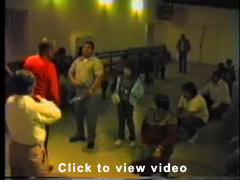| Opening positions: The monarca, malinche, and abuelo are at the back between the two lines of danzantes. The malinche is at the monarca’s right, both facing forward. The abuelo, in front of the malinche, faces her. |
 |
As the dance begins, the danzantes drop slowly into a squat, or kneel with one knee up and the other on the ground. Slowly, while descending, the men heavily swing their arms from side-to-side in a gesture that resembles the one the monarca will use. Once squatting or kneeling, the men keep time with the music by shaking their guajes. |
|
Dance pattern: The dance proceeds in two sections. I. The music for the first section is slower than for any other dance, almost like a drone: four sustained whole notes on one tone followed by seven half-notes in a simple melodic elaboration. The action consists simply of the monarca’s advance from the back to the front of the hall, accompanied by the malinche on his left and the abuelo in front of them, facing the pair and walking backwards. While the malinche and the abuelo simply walk, the monarca does a special step. Bending his knees, leaning slightly forward, and rounding his back, he pivots right to left and left to right, over and over. On the strong, accented beat of the violin, when he is at the extreme of his pivot, he takes a step forward to advance him down the hall. At the same time, accompanying each pivot, he makes a sweeping gesture with the palma, held in his left hand. The gesture starts with his arm across his body and then opens out away from him horizontally as if he is slowly, deliberately pushing something away. There is a smooth, "s"-shaped transition as he moves his arm back in across his body. The monarca’s other hand, with the guaje, is held still at his chest, very lightly beating time. All his moves are slow, broad, and deliberate.
II. When the monarca arrives at the front of the hall, there is a sudden change of music, its tempo faster and livelier. The abuelo, in front of and facing monarca and malinche, calls for them to turn, right then left. Using the double-stamp step of the entrada, monarca and malinche now move down the lines, facing the abuelo and moving backward. As the threesome comes between each pair of dancers, the monarca stamps loudly to raise them up off their knees. One pair at a time, the danzantes rise and join in with the stamping step.
The dance ends when the monarca and malinche reach the back of the hall and all the danzantes are up. The abuelo then calls for turns and everyone bows. |
| <- La entrada |
La
ese ->
|
